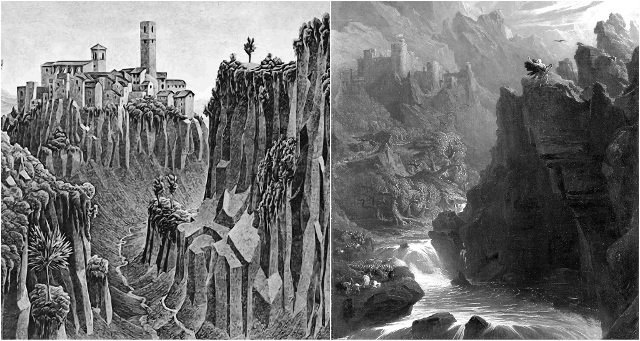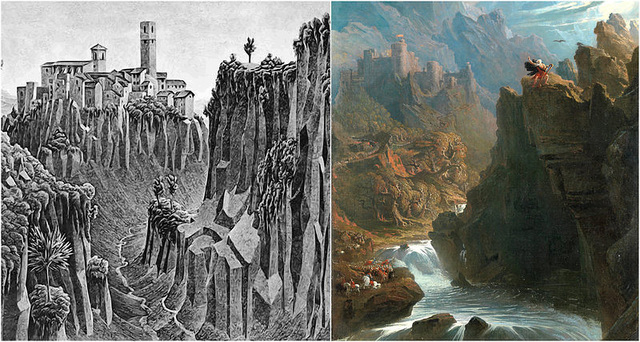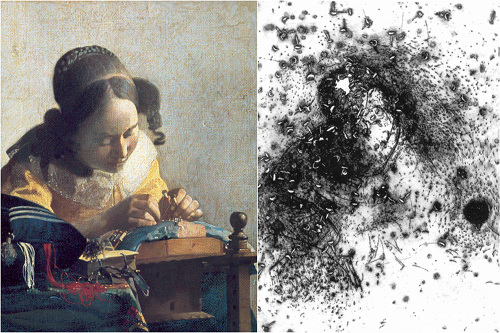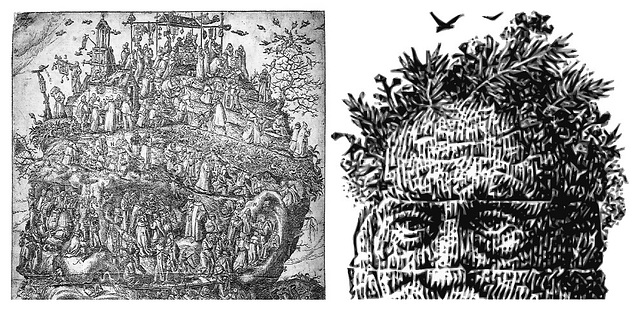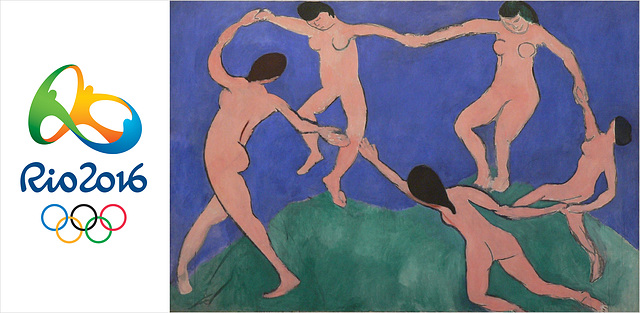
Nonsnark Allusions
Folder: /ˌmisəˈlānēəs/
The comparisons Dalí+Vermeer, Escher+Martin, Millais+Anon.+Galle and Millais+Galle are mine.
19 Jun 2014
1 favorite
2 comments
M. C. Escher's allusion(?) to John Martin's "The Bard"
[left] Maurits Cornelis Escher: Cimino Barbarano , 1929 (in Escher's "Italian" period). This reproduction of the original print has been horizontally compressed and segments on the right side and of the left side of the image have been removed.
[right] John Martin: The Bard , ca. 1817. The colors of the original painting have been completely desaturated and segments on the top and the bottom of the image have been removed.
As for calling this "allusion", I am just polite.
See also: flipsideflorida.wordpress.com/2013/03/06/escher-the-bard
09 Feb 2013
1 favorite
3 comments
M. C. Escher's allusion to John Martin's "The Bard"
www.flickr.com/photos/bonnetmaker/8460032132
This discovery is a kind of "bycatch" from my Snark hunt: M. C. Escher's "Italian" scene shown above (left side) is not a copy like his version (1935) of a segment from a paintig by Hieronymus Bosch. The scene is a more subtile allusion to John Martin's The Bard .
Segments:
[left] Maurits Cornelis Escher: Cimino Barbarano , 1929 (in Escher's "Italian" period )
[right] John Martin: The Bard , ca. 1817
For this side-by-side comparison, I redrew and then horizontally compressed Escher's lithograph after applying selective Gaussian filtering to the image in order to remove details which are not required for the comparison. Parts of the image on its sides have been removed. The top of Martin's painting has been removed too.
Earlier I thought that Escher here perhaps has combined an Italian scenery like Civita di Bagnoregio with what may be supposed to be a (Cambrian?) landscape, as it was there where Edward I went after the Welsh bards. But the landscape is not "Cambrian":
www.socialhistoryofart.com/19thCentury/ ... /John Martin.doc
"Ignoring the Welsh highlands, Martin clearly modeled his landscape on the Swiss Alps which had recently emerged as a major destination for English travelers thanks to the Romantic Alpine poems of Byron and Shelley, among others, and the Alpine landscapes of Koch and Turner. Spurning the tranquil and majestic “Alpine sublime” developed by Koch, Martin took the more dramatic Alpine compositions of Turner and transformed them with his own, quasi-Apocalyptic fervor. In so doing, he gave Alpine landscape the emotional turmoil found in Blake and Byron. And in all this, he took Gray’s Bard into completely new territory, leaving behind all traces of eighteenth-century restraint, decorum, reason, and quiet morality."
Robert Baldwin , 2010
The © for this image applies to the presentation of the discovery of the relation between Escher's print and Martin's painting. Escher's original illustration is © Cordon Art B.V. - Baarn - Netherlands.
See also: flipsideflorida.wordpress.com/2013/03/06/escher-the-bard
15 Sep 2013
6 favorites
3 comments
Johannes Vermeer & Salvatore Dalí: The Lacemaker
¤ Johannes Vermeer: The Lacemaker (1669-1671)
¤ Salvatore Dalí: "paranoiac critical" allusion to Vermeer's The Lacemaker (1958); mirror view.
In 1955, Dalí made a copy of Veermer's work as well as a "rhinocerotic" version and a another "paranoiac critical" version.
In September 2013, artwork from Dalí had been exhibited in the Künstlerhaus in Munich . The exhibits belong to the collection of Richard H. Mayer (Kunstgalerie Böttingerhaus Bamberg) . Among the objects also was one of the prints made in 1958. Interestingly, no hint was given that mirroring Dalí's print could help to understand the allusion. Once rendered in mirror view (as shown above on the right side), Dalí's print is not so abstract anymore.
02 Jun 2013
3 comments
Millais, Anonymous, Galle
[top]: John Everett Millais : Christ in the House of His Parents aka The Carpenter's Shop (1850).
Location: Tate Britain (N03584) , London.
Literature:
* Deborah Mary Kerr (1986): John Everett Millais's Christ in the house of his parents ( circle.ubc.ca/handle/2429/26546 )
p.34 in (01) Éva Péteri (2003): Victorian Approaches to Religion as Reflected in the Art of the Pre-Raphaelites, Budapest 2003, ISBN 978-9630580380 (shortlink: www.snrk.de/EvaPeteri.htm )
* Albert Boime (2008): Art in an Age of Civil Struggle, 1848-1871
p. 225-364: The Pre-Raphaelites and the 1848 Revolution ( en.wikipedia.org/wiki/Special:BookSources/0226063283 )
[center]: Anonymous : Edward VI and the Pope , An Allegory of Reformation, mirrored view (16th century, NPG 4165 ). Iconoclasm depicted in the window. Under the "window" 3rd from left is Thomas Cranmer who wrote the 42 Articles in 1552.
Edward VI and the Pope (NPG 4165) was, until 1874, the property of Thomas Green, Esq., of Ipswich and Upper Wimpole Street , a collection 'Formed by himself and his Family during the last Century and early Part of the present Century' (Roy C. Strong: Tudor and Jacobean Portraits , 1969, p.345). Thus, when Millais' Christ in the House of His Parents ('The Carpenter's Shop') was painted in 1849-1850, the 16th century painting was part of a private collection. It was sold by Christie's 20 March 1874 (lot 9) to a buyer unknown to me, that is, when Holiday started with his illustrations to The Hunting of the Snark .
Location: National Portrait Gallery, London
[bottom]: Philip Galle after Maarten van Heemskerck , Redrawn print Ahasuerus consulting the records (1564). The resemblance to the image above (middle) was shown by Dr. Margaret Aston in 1994 in The King's Bedpost: Reformation and Iconography in a Tudor Group Portrait (p. 68). She also compared the bedpost to Heemskerck's Esther Crowned by Ahasuerus .
Location: Rijksmuseum, Amsterdam
Detail:
The Carpenter and Ahasuerus:
Before I found Millais' allusions as a kind of bycatch of my Snark hunt,
I started with Henry Holiday's allusions to Millais:
An "allusion chain":
Album:
J. E. Millais
14 Apr 2012
1 favorite
1 comment
The Carpenter and Ahasuerus
[left]: Vectorized segment from John Everett Millais : Christ in the House of His Parents aka The Carpenter's Shop (1850).
Location: Tate Britain (N03584) , London.
[right]: Vectorized segment from Philip Galle after Maarten van Heemskerck , Redrawn print Ahasuerus consulting the records (1564).
Location: Rijksmuseum, Amsterdam
24 Jun 2013
3 favorites
2 comments
The Paul Juraszek Monolith (by Marcus Wills, 2006)
I added this to my photostream by courtsey (date: 2010-02-10) of Marcus Wills .
This painting won the Australian Archibald Prize in 2006 . To me it is an excellent example for "art about art", which is an art in its own right. This painting not only is about Marcus Gheeraert's probably most famous etching, it also is about the sculptures of Paul Juraszek (Melbourne). Something like this should be treated like the pictorial equivalent to a good variation of a musical composition (e.g. like Koechlin's variations on BACH).
28 Jul 2013
1 favorite
5 comments
Victor in Your Dreams (2013)
Mahendra Singh (Montréal) holds the copyright to the illustration (depicting Victor Hugo ) on the right side. Compare it to the 16th century etching The Image Breakers (1566-1568, mirror view, right side) by Marcus Gheraerts the Elder.
I added that comparison as shown above to my photostream with Mahendra's consent (2010-07-22).
Source of Mahendra Singh's illustration: justtheplaceforasnark (blog, 2009-12-03)
Mahendra knows the art of deniability very well.
Mahendra's "heads":
• justtheplaceforasnark.blogspot.de/2009/12/dream-books-nonsense-and-bourbon.html
• justtheplaceforasnark.blogspot.de/2013/09/the-heart-is-lonely-snark-hunter.html
24 Jun 2013
2 favorites
1 comment
False Perspective
Satire on False Perspective (1753) by William Hogarth:''Whoever makes a Design without the knowledge of Perspective will be liable to such absurdities as are shewn in this Frontispiece.''
Inset: Kerby (After Hogarth) (1975) by David Hockney,
New York, Museum of Modern Art, Gift of the Artist, J. Kasmin, and the Adversory Committee Fund, 1977
(Reproduction for research purposes with longest side smaller than 200 px)
11 Aug 2014
2 favorites
7 comments
Dancing in Rio 2016
=== left ===
Logo of Olympic games, Rio 2016
=== right ===
Artist: Henri Matisse
Year: 1909
Type: Oil on canvas
Dimensions: 259.7 cm × 390.1 cm (102.2 in × 153.6 in)
Location: Museum of Modern Art, New York City
Source: en.wikipedia.org/wiki/Dance_%28Matisse%29#mediaviewer/File:La_danse_%28I%29_by_Matisse.jpg (uploaded by Fentener van Vlissingen)
See also: www.ipernity.com/doc/laurieannie/24054645
=== Links ===
¤ Discussion: www.google.com/search?q=danse+matisse+olympic+2016
¤ Images: www.google.com/search?q=danse+matisse&num=100&source=lnms&tbm=isch&sa=X
Jump to top
RSS feed- Latest items - Subscribe to the latest items added to this album
- ipernity © 2007-2024
- Help & Contact
|
Club news
|
About ipernity
|
History |
ipernity Club & Prices |
Guide of good conduct
Donate | Group guidelines | Privacy policy | Terms of use | Statutes | In memoria -
Facebook
Twitter

